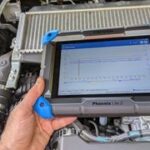Ever wondered, “How Many Miles To Reset Obd2?” after clearing your check engine light? It’s a common question, especially before an emissions test. Driving a certain number of miles after a reset is crucial for your car’s OBD2 system to properly re-evaluate its components. This article explains why mileage matters and offers guidance on ensuring your car is ready for inspection.
Why Mileage Matters After an OBD2 Reset
Your car’s On-Board Diagnostics II (OBD2) system constantly monitors emissions and performance. When the check engine light illuminates, the OBD2 stores a Diagnostic Trouble Code (DTC). Even after fixing the issue and resetting the light, the OBD2 needs time to re-run its diagnostic tests. This is where mileage comes in. Driving allows the system to complete these tests, confirming the problem is resolved and updating its “readiness monitors.” Incomplete monitor cycles can lead to failed emissions tests.
How Many Miles to Reset OBD2: The Drive Cycle
The magic number isn’t fixed, but generally falls between 50-100 miles. The key is completing a “drive cycle”—a series of driving conditions that allow the OBD2 to thoroughly test all systems. This typically includes:
- Cold Start: Starting the engine after it’s been off for several hours.
- City Driving: Stop-and-go driving at varying speeds.
- Highway Driving: Sustained driving at higher speeds.
- Idling: Letting the engine run without moving.
A complete drive cycle ensures all readiness monitors, like those for the catalytic converter and oxygen sensors, switch from “not ready” to “ready.”
Factors Affecting OBD2 Reset Mileage
Several factors can influence the required mileage:
Vehicle Make and Model
Different manufacturers have different drive cycle requirements. Consult your owner’s manual for specific recommendations.
Type of Repair
More complex repairs, like replacing an oxygen sensor or catalytic converter, may require longer drive cycles.
Driving Conditions
A balanced mix of city and highway driving is essential. Primarily city or highway driving may not activate all necessary monitors.
Tips for Completing Your Drive Cycle
- Vary Your Driving: Include a mix of city and highway driving, acceleration, deceleration, and idling.
- Avoid Short Trips: Aim for drives of at least 20 minutes to allow components to reach operating temperature.
- Warm Up Your Engine: Let your car warm up fully before starting your drive cycle.
- Consult a Mechanic: If you’re unsure about your car’s specific requirements, consult a qualified mechanic.
Ensuring OBD2 Readiness for Emissions Tests
To confirm your OBD2 system is ready for an emissions test, you can use an OBD2 scanner. This device plugs into your car’s diagnostic port and displays the status of the readiness monitors. All monitors should show “ready” before you go for testing.
Conclusion
Understanding how many miles to reset OBD2 is crucial for passing emissions tests. By following the recommended drive cycle and monitoring your car’s readiness monitors, you can ensure your vehicle is compliant and avoid unnecessary headaches. Remember, while mileage is a factor, the type of driving you do is equally important. Consult your owner’s manual or a mechanic for specific guidance on your car’s requirements.


